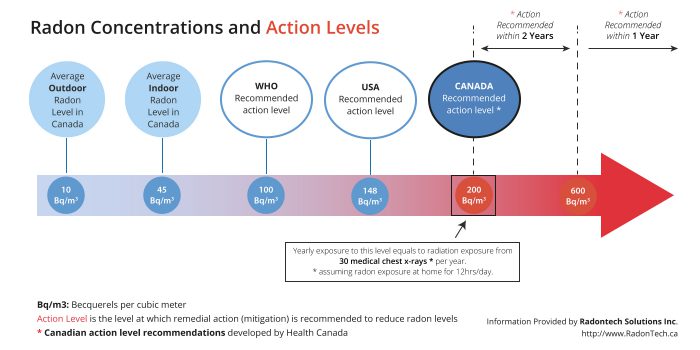Radon Gas and Its Health Risks
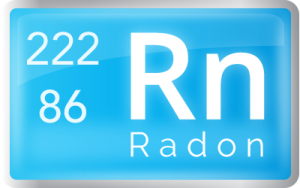
What is Radon Gas?
Radon is an odourless, tasteless, colourless, radioactive gas that is produced from radioactive breakdown of uranium in soils. Radon gas breaks down to form other radioactive elements. Being airborne, radon gas and its products can be inhaled. In the lungs, these particles breakdown further, releasing small bursts of radioactive energy (called alpha particles). These are absorbed by lung tissues damaging them in the process. When cells are damaged, there is an increased risk of developing lung cancer when they reproduce.
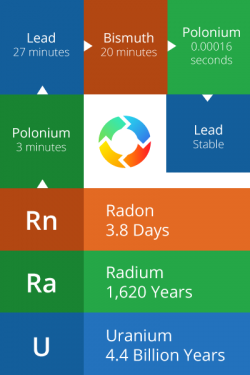
Health risks of radon gas
Radon gas exists everywhere in the environment. However, it is a health concern when it accumulates to high levels in buildings because, due to its radioactive nature, exposure to high levels of radon gas increases the risk of developing lung cancer.
The risk of developing lung cancer from radon exposure depends on:
- How much radon you are exposure to
- How long you are exposed (length of time)
- Whether you smoke tobacco or not
The risk of developing lung cancer increases significantly for tobacco smokers. As an example, the chances of developing lung cancer for a
- Lifelong smoker: 1 in 10
- Lifelong smoker + radon: 1 in 3
- Non-smoker + radon: 1 in 20
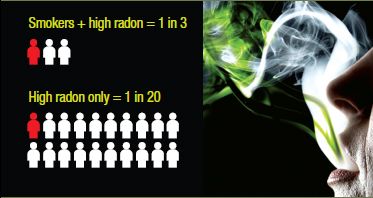
Radon guidelines in Canada
In Canada, the concentration of radon in the air is measured in units of Becquerels per cubic meter (Bq/m3). Basically, 1 Bq/m3 corresponds to one radioactive disintegration per second in one cubic meter of air.
Health Canada and other government agencies in the world have recognized the risk posed by radon gas. These governments have developed guidelines for indoor radon levels known as action levels.
An action level is the level of radon at which remedial action (mitigation) is recommended.
This means that radon levels in homes and buildings are recommended to be below 200 Becquerels per cubic metre (Bq/m3). Any levels of 200 Bq/m3 and above should be fixed (radon mitigation).
Based on this guideline, indoor radon levels are interpreted as follows:
Number of homes with high radon levels (200Bq/m3 and above)
A recent Health Canada study estimates that about 7% of Canadian homes (~600,000) have high radon levels, above the recommended guideline.
How radon enters a building
The most common source of radon gas is the soil. Other less significant sources of radon are well water, and some building materials that may have some trace amounts of radium and uranium (e.g. some granite counter tops, stone features).
A house can act like a vacuum for gases that emanate from the soil. The air pressure inside your house is usually lower than in the soil surrounding the foundation. This is a conducive condition for soil gases like radon to come into a home.
The difference in pressure between the soil and a home can also be caused by natural air movement, particularly in the cold season when warm air from the house moves outside, also known as stack effect. The use of air exchangers, exhaust fans and clothes dryers can also contribute to this effect.
When air is pushed out of the house, outside air is pulled back in to replace it. Much of the replacement air comes from the ground surrounding the house and brings gases such as radon with it.
Radon gas can enter a house at any place it finds an opening where the house contacts the soil. For instance – cracks in foundation walls and in floor slabs, construction joints, gaps around service pipes and support posts, floor drains and sumps, cavities inside walls, and the water supply.
Radon gas can enter a house at any place it finds an opening where the house contacts the soil. Here are some examples of potential entry points:
- Cracks in foundation walls and in floor slabs
- Construction joints
- Gaps around service pipes and support posts
- Floor drains and sumps
- Cavities inside walls
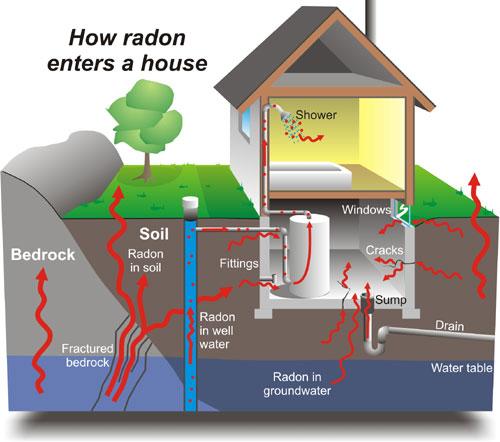
Because radon is a gas, changes in the atmospheric pressure also affect its emission from the ground and its accumulation in indoor air.
The concentration of radon gas in indoor air depends on:
The ease with which radon gas can move through the soil can be influenced by many different factors; porosity of soil, moisture content in soil, building structure and other factors that affect air pressure differentials.
It is not easy to predict radon levels in a home
Given the number of variables involved, every house or building has unique circumstances that can affect radon levels. A number of factors can affect radon levels in a building.
Radon levels have also been shown to vary even by next door neighbours. A recently reported case in Quebec shows radon tests done in two neighbouring homes, where one home had radon levels at 125 Bq/m3 and the next door neighbour had 20,653 Bq/m3!
Some people argue that older homes have are more likely to have entry points for radon and thus are at more risk than newer homes. However, newer homes tend to be more tightly sealed for energy efficiency. This means that radon gas can easily accumulate in the new home.
Ventilation
Ventilation is the first logical measure that homeowners implement to reduce radon levels. While ventilation can help a bit, research has shown that ventilation can both reduce and increase radon levels.
Ventilation can reduce radon levels through mechanical propagation of radon from indoor to outdoor. Ventilation can also increase radon levels by creating a negative pressure that can cause a suction effect on the soil, thus increasing contribution from radon source.
Testing your home for radon gas
You can either purchase a DIY radon test kit to conduct a test at your home or hire a certified radon measurement professional to do it for you.
Radontech Solutions is a certified provider of radon testing services for Edmonton and surrounding areas. Radontech offers radon testing solutions to residential, commercial and public buildings.
If you live in other parts of Canada, you can find a certified radon professional in your area on C-NRPP’s website.
The only way to know the radon concentrations in your home is to test!
What if radon levels in my home are high?
Radon levels can be reduced in any home for about the same cost as other common home repairs. The price range for mitigation, based on a variety of Canadian mitigation providers, is around $1,000 to $3,000. Ultimately the cost will depend on the unique situation of your home, as well as any performance features that will be installed.
The higher the radon levels, the sooner you should mitigate. For levels between 200-600 Bq/m3 it is recommended to perform mitigation within 2 years, while those above 600 Bq/m3 should be mitigated within 1 year.

